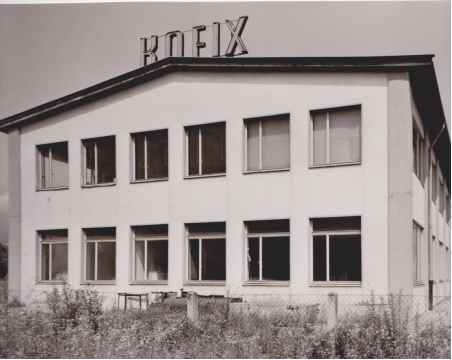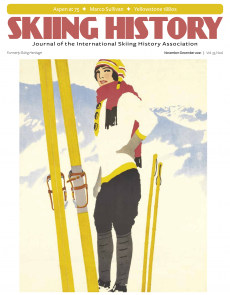SKIING HISTORY
Editor Seth Masia
Managing Editor Greg Ditrinco
Consulting Editor Cindy Hirschfeld
Art Director Edna Baker
Editorial Board
Seth Masia, Chairman
John Allen, Andy Bigford, John Caldwell, Jeremy Davis, Kirby Gilbert, Paul Hooge, Jeff Leich, Ron LeMaster, Bob Soden, Ingrid Wicken
Founding Editors
Morten Lund, Glenn Parkinson
To preserve skiing history and to increase awareness of the sport’s heritage
ISHA Founder
Mason Beekley, 1927–2001
ISHA Board of Directors
Rick Moulton, Chairman
Seth Masia, President
Wini Jones, Vice President
Jeff Blumenfeld, Vice President
John McMurtry, Vice President
Bob Soden (Canada), Treasurer
Einar Sunde, Secretary
Richard Allen, Skip Beitzel, Michael Calderone, Dick Cutler, Ken Hugessen (Canada), David Ingemie, Joe Jay Jalbert, Henri Rivers, Charles Sanders, Christof Thöny (Austria), Ivan Wagner (Switzerland)
Presidential Circle
Christin Cooper, Billy Kidd, Jean-Claude Killy, Bode Miller, Doug Pfeiffer, Penny Pitou, Nancy Greene Raine
Executive Director
Janet White
janet@skiinghistory.org
Membership Services
Laurie Glover
(802) 375-1105
laurie@skiinghistory.org
Corporate Sponsorships
Peter Kirkpatrick
(541) 944-3095
peterk10950@gmail.com
Bimonthly journal and official publication of the International Skiing History Association (ISHA)
Partners: U.S. Ski and Snowboard Hall of Fame | Canadian Ski Museum and Hall of Fame
Alf Engen Ski Museum | North American Snowsports Journalists Association | Swiss Academic Ski Club
Skiing History (USPS No. 16-201, ISSN: 23293659) is published bimonthly by the International Skiing History Association, P.O. Box 1064, Manchester Center, VT 05255.
Periodicals postage paid at Manchester Center, VT and at additional mailing offices. Postmaster: Send address changes to ISHA, P.O. Box 1064, Manchester Center, VT 05255
ISHA is a 501(c)(3) public charity. EIN: 06-1347398
Written permission from the editor is required to reproduce, in any manner, the contents of Skiing History, either in full or in part.
Walter Kofler Invents the Polyethylene Ski Base
Before P-tex, there was Kofix. It drove a revolution in ski racing.
When Alpine skis had wooden bases, it was common to waterproof them with celluloid lacquer, made by dissolving celluloid in ether, acetone or alcohol. Each factory had its own name for this stuff – Plasticite, Celloblitz and so on. It made a smooth glossy surface but soon wore thin. When the wood started to show through, skiers could paint on a lacquer sold in cans, under brand names like Faski and Blue Streak.
Photo above: Kofix headquarters, Hall im Tirol near Innsbruck. All photos courtesy of Barbara Kofler.
With the end of World War II, European ski factories resumed production, with a few new adhesives and plastics. Early in 1945, within months of Liberation, Dynamic began using a solid sheet of celluloid – not a lacquer – to improve glide speed. “Cellolix” repelled water, held wax and resisted rock damage, but as it aged it often cracked. Nonetheless, celluloid was a great solution for the first aluminum skis, and was used, in the form of a softer sticky-tape film, by TEY on their Alu-60 ski. Attenhofer coated the bottom of its metal ski with Araldite, an epoxy resin invented during the war in Switzerland, and called it Temporit.

speedometer-headed skier.
Polyethylene: Classified secret in WWII
Polyethylene (PE) waited in the wings. PE production was devised in England in 1939. With the outbreak of war, the material was classified secret, because it was perfect for insulating coaxial cables used in radar sets and for wiring insulation in Allied warplanes. In 1951, a cheaper form of PE came into wide use for packaging.

c 1933.
Walter Rudolf Kofler (1928-2004) grew up in Innsbruck as an enthusiastic ski racer. He turned 17 in May, 1945, just a week after the American 409th Infantry Regiment occupied Innsbruck. That summer Kofler entered the University of Innsbruck. He earned his doctorate in physics, at age 21, in 1949.
How to glue it?
Before graduating, Kofler noticed that the new PE material felt a lot like the solid form of paraffin wax. Its chemical structure was perfectly compatible with paraffin, and Kofler thought it might make a useful ski base. But PE was so slippery that, unlike celluloid, no glue could hold it to the bottom of a ski. Kofler hit on the idea of partially melting one side of a PE sheet to a strip of cotton fabric; the fabric could then be glued to the ski. He also mixed a lot of wax into the molten plastic.
Local ski factories Schlechter, Halhammer, Vielhaber and Messerer tested the new base successfully, and in October, 1952, Kofler applied for an Austrian patent for a “ski base made of fabric-laminated polyethylene.”

In 1954 he set up a factory in Munich and pitched the product to major ski factories, under the brand name Kofix. It was expensive. Swiss and American factories, with the advantage of strong currencies, could buy the stuff easily, and the Swiss company Montana purchased a license to make its own version of Kofix, for sale to Swiss and French ski factories.
Racing advantage
But the cash-strapped French and Austrian factories were slow to adopt Kofix for mass production skis. Its superior glide speed obviously conferred an advantage for racing, and by the 1956 Olympics in Cortina, racers on Kästle and Kneissl skis had Kofix bases. Austrians won nine of the eighteen medals, including Toni Sailer’s three golds plus Anderl Molterer’s silver and bronze, and Swiss skiers on Kofix won another three.
Sailer was unbeatable on any ski base—he whipped Molterer, also equipped with Kofix, by six seconds in the GS. French racers, still skiing on Cellolix bases, were shut out of the medals entirely—eight seconds off the pace in GS and almost ten seconds out in slalom and downhill. A year later the entire Austrian team

had Kofix bases, and they took six of the top seven places at the Hahnenkamm. According to Maurice Woehrlé, who joined Rossignol’s engineering team in 1962, in 1957 Rossignol used a form of PE, called Naltene, on the Metallais—but that wasn’t a race ski.
Woehrlé also reports that Charles Bozon and Guy Périllat used Dynamic’s Slalom Leger, with a PE base, at the Squaw Valley Olympics. Bozon took bronze in slalom. That was the breakthrough year for Rossignol’s Allais 60, the first aluminum ski to dominate downhill racing, and it got a PE base. So it would appear that all the men’s medals in 1960 were won on PE bases. Rossignol’s slalom and GS Stratos didn’t get PE until 1964—which is when the French team began its dominant Killy-Périllat-Goitschel era.
In 1960, Kofix turned up in the Head, Hart and Northland catalogs. But as late as 1958, skiers were still confused about what constituted a “plastic” base. In their book The New Invitation to Skiing, Fred Iselin and A.C. Spectorsky classed Kofix with half a dozen brands of celluloid lacquer.
A problem arose with the cotton backing: If a ski absorbed moisture, the fabric softened and swelled, deadening the ski. Kofler kept working on upgrades: harder, tougher plastics, plus PE extruded onto steel and fiberglass strips, which replaced cotton while functioning as a structural layer. By 1959, most Austrian, Swiss and German factories offered Kofix recreational skis, but resented Kofler’s monopoly.

Competition from P-tex
In 1964, Swiss licensee Montana introduced P-tex. Because it didn’t use a cotton backing, it didn’t violate Kofler’s patent. Instead, the bonding side of the plastic was flame-treated, which put a carbon “tail” on each of the long polyethylene molecules, so it could be glued solidly to a fiberglass or aluminum ski.
Beginning with Fischer, Kofler’s customers stampeded to adopt Montana’s P-tex, going so far as to exclude Kofler from trade shows. In 1966, Montana introduced a sintered base called P-tex 2000. It was far harder and more durable than the extruded forms of PE previously available. That was the end of the line for Kofix. In 1970, Kofler turned his patents over to an employee, who continued to manufacture the product as Fastex.
Kofler then developed a ski made of extruded strips of ABS plastic, rolled out on laminating equipment he designed. He built his own line of Rebell skis, and licensed the process to Maxel and Sarner in Italy. By 1976 it was clear that extruded skis couldn’t compete with the major factories, and the concept evaporated.
Kofler continued to ski, and to innovate. In 1988 he patented a lightweight fiberglass leaf spring for cars, trains and trucks, and a tough surface for Kneissl’s Big Foot skis and for snowboards, produced in his lab in Innsbruck. He consulted with the Austrian ski team on glide speed issues. In 2004, at age 76, while driving to a masters ski race, he suffered a fatal heart attack.
Many thanks to Werner Nachbauer and Arno Klien for their generous assistance in gathering German-language sources for this article, and to Barbara Kofler for fact-checking.
Seth Masia is president of ISHA. He writes frequently for Skiing History.
Table of Contents
WORLD CHAMPIONSHIP ($3,000+)
BerkshireEast/Catamount Mountain Resorts
Gorsuch
Warren and Laurie Miller
Sport Obermeyer
Polartec
CHAMPIONSHIP ($2,000)
Fairbank Group Resorts
Hickory & Tweed
Rossignol
Snowsports Merchandising Corporation
WORLD CUP ($1,000)
Aspen Skiing Company
Bogner of America
Boyne Mountain Resort
Dale of Norway
Darn Tough Vermont
Dynastar/Lange/Look
Gordini USA Inc/Kombi LTD
Head Wintersports
Intuition Sports
Mammoth Mountain
Marker/Völkl USA
National Ski Areas Association
Outdoor Retailer
Ski Area Management
Ski Country Sports
Sports Specialists LTD
Sun Valley Resort
Vintage Ski World
World Cup Supply
GOLD MEDAL ($700)
Larson's Ski & Sports
Race Place/Beast Tuning Tools
The Ski Company (Vicki and Gary Profetta)
Thule
SILVER MEDAL ($500)
Alta Ski Area
Boden Architecture PLLC
Dalbello Sports
Deer Valley
EcoSign Mountain Resort Planners
Elan
Fera International
Holiday Valley Resort
Hotronic USA
Masterfit Enterprises
McWhorter Driscoll LLC
Metropolitan New York Ski Council
Mt. Bachelor
New Jersey Ski & Snowboard Council
Russell Mace Vacation Homes
SchoellerTextil
Scott Sports
Seirus Innovations
SeniorsSkiing.com
Ski Utah
Steamboat Ski & Resort Corp
Sundance Mountain Resort
Swiss Academic Ski Club
Tecnica Group USA
Timberline Lodge and Ski Area
Trapp Family Lodge
Western Winter Sports Reps Association
World Pro Ski Tour
Yellowstone Club


